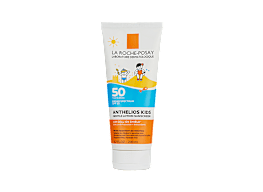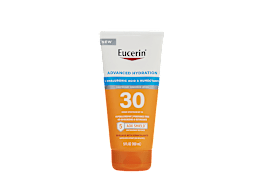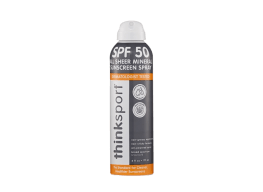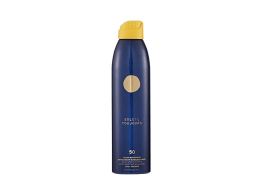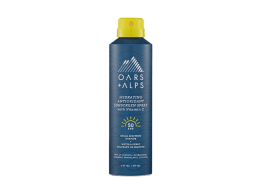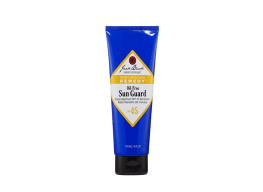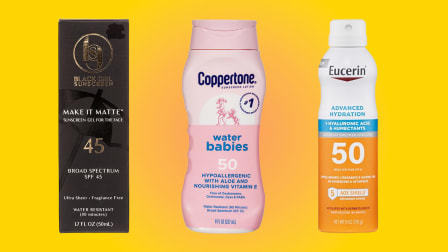When Can Babies Wear Sunscreen?
And everything else you need to know about infant sun protection
When you shop through retailer links on our site, we may earn affiliate commissions. 100% of the fees we collect are used to support our nonprofit mission. Learn more.

When you’re getting ready to head out the door with your baby, there’s a lot to think about, pack, and plan for. And just like you’d never dream of leaving the house without an adequate supply of diapers, you also shouldn’t leave without having a sun-protection game plan. “Summer or winter, the sun’s rays can quickly damage a baby’s delicate skin,” says Joel L. Cohen, MD, a dermatologist in Denver and associate clinical professor of dermatology at University of California, Irvine.
At What Age Can Babies Wear Sunscreen?
The Food and Drug Administration and the American Academy of Dermatology recommend not using sunscreen on infants under 6 months old. “That’s mostly because there are no studies on the safety and efficacy in infants that young,” Torres-Zegarra says. Infants are also more likely to get a rash or other reaction to some sunscreen ingredients.
Yet their skin is especially susceptible to burning ultraviolet (UV) rays. “Infant skin is very thin,” she says. “A baby’s skin doesn’t fully finish developing until they are about 2 months old.” Rather than using sunscreen, you should keep babies in the shade as much as possible and dress them in clothing that covers their bodies, such as a lightweight long-sleeved shirt and pants. A wide-brimmed hat can shield their face and neck.
That said, there are times when sunscreen may be needed, even on an infant under 6 months old. “It’s better to use a little sunscreen than to let them get burned,” Cohen says. (Sunburn on an infant can be serious. If your baby gets sunburned, call your pediatrician.) “When my kids were babies, we definitely used sunscreen on exposed skin when necessary—especially when they’d be out in the strong sun at high altitude in the mountains,” says Cohen, who, in addition to being a dermatologist, is married to a pediatrician and is a father of three. “We didn’t slather it all over them, but used it as needed to make sure they were fully protected.”
Will Your Baby Get Too Hot in the Sun if They're Covered With Clothes or a Blanket?
“It’s true that babies do tend to get overheated more easily than older kids,” says Judith Hoffman, MD, a pediatrician in New York City. “Newborns and young babies can’t yet control and regulate their body temperature as well.” So while you want to cover them, don’t swathe them in multiple layers or heavy fabrics on a hot day. Look for lightweight sun-protective clothing rated ultraviolet protection factor (UPF) 50 or higher. These thin, breathable fabrics are specially formulated to protect without feeling suffocating.
Is It Enough to Just Keep Your Baby in the Shade?
Seeking shade is an excellent sun-safety strategy, but it’s not foolproof, so you also need to stay covered up. Some UV rays may still penetrate your shade cover or some parts of your baby may still be exposed (a bare foot sticking out from the stroller’s awning, for example). During midday, when the sun is at its peak strength, even the shade can’t provide total protection.
“You also need to consider the reflection of the sun’s rays off of sand, water or cement that can reach you even when you’re under an umbrella,” Cohen says. The World Health Organization estimates that water reflects about 10 percent of UV rays; sand and concrete, about 15 percent; and snow, up to 80 percent.
Once Your Baby Is Ready for Sunscreen, What's the Best Kind?
Most dermatologists—as well as the American Academy of Dermatology—recommend mineral-based sunscreens for babies who are at least 6 months (and for younger infants if you must use sunscreen on them). These sunscreens contain the ingredients titanium dioxide, zinc oxide, or both, which are less likely to cause a rash or other skin irritation. (See our review of the best mineral sunscreens.) But that’s not a hard-and-fast rule, and in Consumer Reports’ annual testing, mineral sunscreens consistently don’t work as well as those made with chemical sunscreen ingredients.
Regardless of which kind of sunscreen you choose for your baby, it’s still important to use other protective measures, such as staying in the shade and covering up. “No sunscreen is perfect, and none is 100 percent effective,” Torres-Zegarra says. Note, too, that sun protection, including sunscreen, is important for people of all skin tones.
How Can You Tell Which Sunscreen Chemicals Are Safe?
Concerns about chemical sunscreens have increased since 2019, when the FDA took 12 chemical sunscreen ingredients—such as avobenzone, octinoxate, and oxybenzone—off the Generally Recognized As Safe and Effective (GRASE) list. The FDA suspected, and studies subsequently confirmed, that these ingredients are absorbed through the skin into the bloodstream more than previously thought.
While this raises real concerns, at this point the risks are more theoretical than proven. The FDA said that it needs more in-depth research on the effects of this absorption, but it also said that people shouldn’t stop using these sunscreens. Chemical sunscreens are still considered safe, especially for older children and adults who don’t have sensitive skin, Torres-Zegarra says. And the use of any sunscreen—chemical or mineral—is safer than unprotected exposure to the sun.
The ingredient that has taken the most heat is oxybenzone. There are some animal studies suggesting that it might interfere with hormone production, which theoretically could affect fertility, puberty, and thyroid function. Although sunscreen research that has been done in humans hasn’t raised any major concerns, the American Academy of Pediatrics suggests using a sunscreen that doesn’t contain oxybenzone. The good news: Many companies have reformulated their products to provide effective sun protection without that ingredient. The majority of the 71 sunscreens in CR’s ratings do not contain oxybenzone.
What's the Best Sunscreen: Lotion, Spray, or Stick?
Any of those delivery methods can work for babies, you just need to use them properly. With a lotion, apply about 2 teaspoons of sunscreen to cover your baby’s exposed face, arms, and legs. Sticks are best for protecting small areas of delicate skin—slather them over lips and ears, on the nose, and around the eyes. Sprays aren’t most dermatologists’ first choice for infants, mostly because of concerns about them inhaling it, but they still work in a pinch. “Just don’t spray it directly onto your baby,” Torres-Zegarra says. “Spray some into your hand and then apply it to your baby’s skin.”
No matter what you use, don’t forget to reapply it throughout the day. “Sunscreens are really only effective for about 2 hours,” Cohen says. “So you need to reapply it every 2 hours or right away after going in the water.”
Does Your Baby Need a 'Baby' Sunscreen?
You don’t have to use a baby-specific sunscreen on your infant. “That is mostly about marketing, not about safety or effectiveness,” Torres-Zegarra says. You can use the same sunscreen you use for the rest of the family—and baby sunscreens are fine for older kids and adults to use, too. Instead of focusing on that language on the label, look for the information that really matters. You need to make sure any sunscreen you use has an SPF of 30 or higher and provides broad-spectrum protection against both UVA and UVB rays. If you plan to go in the water with your baby, make sure the label also says “water resistant.”
Top Sunscreens From CR's Tests
All the sunscreens at the top of CR’s ratings contain chemical active ingredients, such as avobenzone. Some people may prefer to use a mineral (or natural) sunscreen, those with zinc oxide, titanium dioxide, or both. But in our tests over the years, mineral sunscreens haven’t performed as well. A couple of the better ones are included here. All sunscreens are listed in alphabetical order.

















